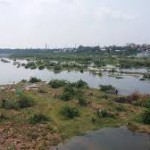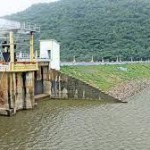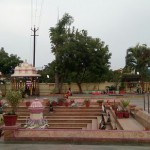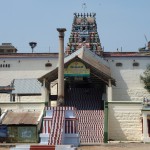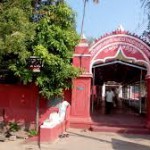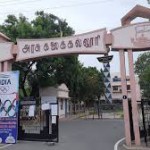| Karur Districts |
| About: |
| Karur District are magnificent set of sculptures and architecture that not only reflect the religious domain of the district, but its artistic skills as well. Karur District of Tamil Nadu is surrounded by Namakkal District in the north, Dindigul District in the south, Tiruchirapalli District in the west and Erode District in the east. Since Karur was an ancient battleground, the temples of Karur District reflect the sculptures of brave warriors. Karur is an ancient city of Tamil Nadu, also an administrative district of the state. It is the most centrally located district of Tamil Nadu which was once a part of Coimbatore district. The Taluk Karur was merged with Tiruchirappalli district during 1910. A separate Karur district was formed on 30th September 1995 by trifurcating Tiruchirappalli district.Karur District of Tamil Nadu is bounded by Namakkal District in the north, Dindigul District in the south, Tiruchirapalli District in the west and Erode District in the east. History reveals that Karur was an ancient battleground.Karur District has an area of 2,895 sq km and a population of over 1 million. The common languages spoken are Tamil, Telugu, English and Urdu. Rice, millets, pulses, sugarcane, groundnut, gingelly and cotton are the major agricultural crops. The Chettinad Cement Factory and Puliyur Sugar Factory are situated in Karur District.The geographical location of the district is in such a way that, it is bounded by Namakkal District in the north, the Dindigul District in the south, the Tiruchirappalli District on the east and Erode District on the west. The city is famous for its cottage industries. The Chettinad cement factory is located here. Milled rice, cotton fabrics, and brassware are the city’s chief products.Farmers of the district of Karur are mainly engaged in the cultivation of Rice. Other crops grown in the region are millets, cereals, pulses, sugarcane, groundnut, and cotton. The major industries of the region are paper, bus body building and cement industries. A very common cottage industry is handloom industry engaged in the export of bed sheets, towels, floor rugs, tea towels, napkins, aprons, kitchen towels, pot holders, bathmats, tea mats, curtains, quill covers, shower curtains etc. People from far off places come to visit the Pasupatheesvarar Temple at Karur, built by the chola kings in the 7th century. |
| Karur city has a glorious history and rich past. It was ruled by the Cholas, the Naickers and the British successively. The century old monuments still exist, which offer glimpse of the Karur’s past culture and civilization. The major tourist attractions in thedistrict include Kalyana Venkattaramasami temple, Pasupathieswarer Temple, Sri Mariamman Temple, etc. |
| Location info: |
| Karur District ,Tamil Nadu,India |
| Climate/Weather of Karur Districts: |
| The highest temperature is obtained in early May to early June usually about 37 °C, though it usually exceeds 39 °C for a few days most years. Average daily temperature in Karur during January is around 24 °C, though the temperature rarely falls below 19 °C.The average annual rainfall is about 615 mm. The city gets most of its seasonal rainfall from the north-east monsoon winds, from late September to mid November. |
| History of Karur Districts: |
| Karur is one of the oldest towns in Tamil Nadu and has played a very significant role in the history and culture of the Tamils. Its history dates back over 2000 years, and has been a flourishing trading centre in the early Sangam days. It was ruled by the Cheras, Gangas, Cholas, the Vijayanagara Nayaks, Mysore and the British successively.Karur was built on the banks of river Amaravathi which was called Aanporunai during the Sangam days. According to the Hindu mythology, Brahma began the work of creation here, which is referred to as the “place of the sacred cow.” The names of the early Chera kings who ruled from Karur, have been found in the rock inscriptions in Aaru Nattar Malai close to Karur. The Tamil epic Silapathikaram mentions that the famous Chera King Senguttuvan ruled from Karur.Epigraphical, numismatic, archaeological and literary evidence have proved beyond doubt that Karur was the capital of early Chera kings of Sangam age. It was called Karuvoor or Vanji during Sangam days. There has been a plethora of rare findings during the archaeological excavations undertaken in Karur. These include mat-designed pottery, bricks, mud-toys, Roman coins, Chera Coins, Pallava Coins, Roman Amphorae, Rasset coated ware, rare rings, etc Karur may have been the center for old jewellery-making and gem setting with the gold imported mainly from Rome, as seen from various excavations. In 150 Greek scholar Ptolemy mentioned “Korevora” Karur as a very famous inland trading center in Tamil Nadu.Karuvoor Thevar born in Karur, is one among the nine devotees who sung the divine Music Thiruvichaippa, which is the ninth Thirumurai. He is the single largest composer among the nine authors of Thiruvichaippa. He lived during the reign of the great Raja Raja Chola I. In addition to the famous Siva temple, there is a Vishnu temple at Thiruvithuvakkodu suburb of Karur, sung by famous Kulasekaraazhvaar 8th century AD. The same temple is presumably mentioned in epic Silappadikaram as Adaha maadam Ranganathar whose blessings Cheran Senguttuvan sought before his north Indian expedition. |
| Educational Institutions of Karur Districts: |
| Arts & Science:Dr. Kalaignar Government Arts College, Kulithalai Govt. Arts College, Karur Annai Women’s College, Karur Arungarai Amman College of Arts and Science, Karur Cambridge College of Arts and Science, Karur Kongu College of Arts and Science, Karur Sri Sarada Niketan College of Science for Women, Karur Valluvar College of Science and Management, KarurHotel Management:Valluvar Catering and Hotel Management Institute, Karur Valluvar College of Science and Management, KarurEngineering:Chettinad College of Engineering and Technology, Karur M. Kumarasamy College of Engineering, Karur Taluk V.K.S. College of Engineering and Technology, Karur V.S.B. Engineering College, Aravakkurichi TalukNursing:Sakthi College of Nursing, Karur Sri Aurobindo College of Nursing, KarurManagement:M. Kumarasamy College of Engineering, Karur Taluk V.S.B. Engineering College, Aravakkurichi TalukPolytechnic:The Karur Polytechnic College, KarurTTI:Aasee College of Education, Karur Aasee Teacher Training Institute, Karur B.T.K. Teacher Training Institute, Karur Jairam College of Education, Karur Jairam Teacher Training Institute, Karur John Teacher Training Institute, Kulithalai Taluk Kaliammal College of Education, Karur M. Kumarasamy College of Education, Karur M.S.E.S. College of Education, Karur Ponkaliamman College of Education, Karur Rasama College of Education, Karur Rasama Teacher Traning Institute, Karur Servite College of Education, Karur Sri Balaji Institute of Teachers Training Institute, Karur Sri Subramaniyaa Teacher Training Institute, Kulithalai Taluk |
| Langauge |
| Kannada, Malayalam, Telugu and Urdu. |
| Culture: |
| Tamil Nadu finds a prime position on the cultural map of the country. The state’s contribution to literature, music, arts of Indian classical culture is praiseworthy. Dance, music, art and crafts and celebration of various festivals form important parts of Tamil culture. The various fairs and festivals are celebrated with great enthusiasm. Tamil people have their own living style which is reflected in their food, costumes, language and folk art and culture. Let’s find more about thecultural heritages of the state.Faiirs and ffesttiivalls: The people of Karur, Kulithalai and Kulathur venerate Goddess Mariyamman, which draw record crowds. Christians and Muslims festivals are also celebrated in this district with fun and fare. |
| How to reach? |
| Nearest Railway Station:Karur (Station Code – KRR) is connected to the Indian Railways network. Trains from Mysore to Tuticorin, Mangalore to Chennai, Coimbatore to Mayiladuthurai Janshatabdi Express and Mysore to Mayiladuthurai, Nagercoil to CST Mumbai, Madurai to Manmad and Madurai to Jammu Tawi via New Delhi, Rohtak, Ludhiana, Jalandhar, Pathankot (Chakki Bank) travel via Karur. Karur is also connected by rail to major towns like Coimbatore, Madurai, Chennai, Trichy, Salem, Erode, Bangalore, Hyderabad, Tirupathy, Mumbai. |
| Nearest Airport:Airport is in Trichy (78 km), Coimbatore (122 km) and Madurai (135). |
| Road Transport:Karur is well connected with rest of India through all modern means of transportation. There are 2 National highways NH-7 (North South Corridor(Kashmir to Kanyakumari)) Varanasi – Kanyakumari) and NH-67 (Nagapattinam – Trichy – Karur – Coimbatore – Ooty) that ply through Karur. |
| Tourist Attraction of Karur Districts: |
| The Kalyana Venkattaramasami Temple: The Kalyana Venkattaramasami Temple at Thanthoni and Pasupatheswarar Temple at Karur are the main tourist centers in this district. Kadambar Koil and Iyer Malai at Kulittalai, Mariamman Temple, Vennaimalai and Pasupatheswarar Temple at Karur and Venjamangudalur Temple at Venjamangudalur are some of the major temples of Karur District.The Kalyana Venkattaramasami temple: The Kalyana Venkattaramasami temple at Thanthoni is considered to be the main temple of Karur District. The shrine of the Lord is situated on a raised portion of a hillock and the temple is popular as the Tirupathi. Karur town is one of the seven sacred sthalams (place) of Sivalayams and is widely known for famous Pasupathieswarer Temple. The group of sculptures representing Pasupathiswaralingam as high as five feet is bathed by the milk oozing from the udder of a cow and Rangamatha are distinguished for sculptural beauty.Mariamman Temple: The temple in Pugalur is situated north west of Karur and dedicated to Lord Subramania on a small hill at Velayuthanpalayam near Cauvery is famous for superb sculpture. Sri Mariamman Temple is one of the famous temples of Karur District, which is situated in the heart of the city. The temple festivals are celebrated periodically during the month of May by all age gropus, irrespective of caste and creed, taking the `Kumbum` from the temple to the Amaravathi River is the glorious act for the pilgrim.Shree Kalyana Pasupatheeswarar temple: Shree Kalyana Pasupatheeswarar temple or the Thiru Aanilai, Karur Shree Abayapradhana Ranganathar temple, Karur Shree Karuvur Mariyamman temple, Karur Thanthondrimalai, Shree Kalyana Venkataramanaswamy temple, Vennaimalai Shree Balathandayuthapani temple, Attur Sholiyamman temple and Vangal Shree Vangalamman temple are some of the prominent temples of Karur District.Perur Patteeswara Swamy temple: Perur Patteeswara Swamy temple is the most popular temple in the city. Built by the King Karikala Cholan, this temple is situated 7 kms west of Coimbatore near river Noyyal.The presiding deity is Shiva and the ‘Swayambu Lingam’ is the idol worshipped here. This sanctum is the joint effort of the Chola, Hoysala and Vijayanagara rulers during their reign. The greatest attraction of the temple is the ‘Kanaka Saba’ or the golden hall which is adorned by a gold plated statue of Nataraja bestowing blessings upon the two sages – Gowmuni and Pattimuni. The gopurams and pillars of the hall are exquisitely carved out sculptures highlighting Dravidian architecture.The significance of Perur temple in earlier days are unfolded in the poetic creations of Arunagiri Nather and Kachiappa Munivar. The temple stands on the banks of the holy river Noyyal called ‘Kanchi Manadi’ by the locals. Pilgrims from all over visit this spot to pay homage to their ancestors. It is believed that the mortal remains of the dead turn into white stones after about 144 days.Marudha Malai Temple: About 12 Kilometers away from Coimbatore Railway Station is the Marudhamalai temple of Lord Muruga. As the name suggests, the temple is situated on a hillock and the presiding deity is called Dhandayuthapani. The celebrations of this temple are ‘ Thaipoosam’ and ‘ Thirukarthigai ‘ in January and February. Pollachi, an important commercial centre about 40 Kms away from Coimbatore, is famous for it’s Mariyamman and Subramanya temples.The South Banaras or Avanashi Temple is the biggest temple in the district famous for it’s exquisite carvings & sculptures.Dhyanalinga Multi – Religious Temple: The Dhyanalinga Multi – Religious Temple situated at Vellingiri foothills about 30kms from Coimbatore is very much a part of this glorious tradition. Dhyanalinga was consecrated by Sadhguru Jaggi, Vasudev, a realized Master, Mystic and Yogi, after three years of intense process of prana prathista. Measuring 13′ 9”, Dhyanalingam is the largest mercury based live Linga in the world. It does not require minutes within the sphere of Dhyanalinga is enough to make even those unaware of meditation to experience a state of deep meditativeness and feel the divine energy that overflows from this glorious form. The free spanning dome that enshrines the Dhyanalingam measures 77′ in diameter and is the largest of its kind in the world. This divine instrument radiates seven different qualities on seven different days of the week by which one can derive various benefits.Arulmigu AranganathaSwamy Thirukoil: At Karamadai, a place near Mettupalayam there lived people by the name ” Thottiyars “. One of the Thottiya had a (Karai Pasu) cow. All off a sudden, for a few days the cow did not give him milk. Filled with anger the thottiya followed the cow and found his cow shedding milk to a Kaarai bush, the thottiya became very furious and with his knife banged the bush and a sound exploded from the bush and blood started gushing out of the bush, people knowing this rushed to the spot and found a Suyambu Lingam inside the bush, the same night the God appeared in the dream of thottiya and ordered the thottiya to glorify him with ” Chandana Kaapu “, So did the thottiya and found that it was a beautiful Ranganathar Suyambu (which is said to be growing in size every year).Arulmigu Poondi Velliyangiriandavar Thirukoil: Velliyangiri is a beautiful temple situated in one amongst the five hills of historical importance. The five hills symbolically represents the five different faces of Lord Shiva. This is the only temple where PanchaLinga can be seen. Lord Brahma was fast asleep and lacked in his duty. So to overcome his sin he started meditating at Himalayas where he got Shiva Dharisanam and was guided to continue his meditation in the name of Pattimuni at perur.Arulmigu Poondi Velliyangiriandavar Thirukoil: Aanaimalai, a place near Pollachi was earlier ruled by a king called Naanan. He had a very special mango tree in his farm on the riverside of Aaliyar, which he was so fond of. He was so particular that nobody was allowed to use neither the mangoes nor its leaves. Once, a group of girls were having their bathe in the Aaliyar river and saw a mango floating on the river which belonged to nanans tree, on anxiety one of the girl picked the mango and ate it, even after several pleadings made by her father, the king sentenced her to death. After some time the villagers in that particular area formed a female figure in lying state in remembrance of the innocent girl on the graveyard sand and started worshipping her. In due course she was worshipped by the name “Maasani” Later Kozhinkhosargal defeated king Naanan and destroyed that particular mango trees. It is believed that Lord Rama on his way in search of Seetha, was absorbed by the power of this temple, stopped here and performed his meditation adding glory to this temple.Arulmigu Eachanari Vinayagar Temple: This temple is located at 10 kms from Coimbatore on Pollachi road. It is one of the oldest temple in Coimbatore and dates to 1500 A.D. The Moolavar at this temple was actually meant for Perur Patteshwarar temple and since it got stuck on its way from Madurai, Eachanari became the blessed place. The deity’s height is 6 feet and the width is 3 feet and is one of the biggest in South India. |
| Hotels/Lodge/Accommodation in Karur Districts: |
| Hotel Hemala:No.9,Police Lane Street, Police Lane,Karur, Tamil Nadu,Ph04324 262922Archana Hotels:( Pure Veg ):Karur,Tamil NaduHotel Femina (P) Ltd:Williams Rd, Tiruchchirappalli, Tiruchirappalli, Tamil Nadu,Ph:0431 2414502Hotel Sangam:Collector Office Road, Tiruchirapalli, Tamil Nadu,Ph:0431 2414700 |
| Links: |
| http://www.karur.tn.nic.in/climate.html |
